When I started working as a set designer in films the terminology of the profession in Germany was rather theatrical. At the academy the sign on the classroom door said "BÜHNENBILD" (stage picture), but classically educated also understood Szenenbild or Szenographie. In TV, where I started working a little later and was making flats and cubes for educational programs, it was all called Szenenbild. In the movies, things were more confusing because as an art – and industry – that had flourished under National Socialism it had acquired purely German terminology. I guess that was the origin of Gesamtausstattung (total outfit), which I write about in the introduction to "THE TIN DRUM" DESIGN page, but there still exited such terms as Filmarchitekt or Filmbildner of East German provenience. My friends and colleagues Heidi and Toni Lüdi wrote an entire treatise on the job definition. In the mid ‘70s the industry adopted the English terminology to distinguish the set dresser from the set designer and producers were giving away titles such as art director and production designer. Just as all actors are called actors, or in Hollywood even "talent", it is said that there exist "production designers" who never used a pencil in their lives. This may actually be true, because on Hollywood films the production designer has a large staff of consultants and specialists for each aspect of the work. In the films that I worked on I knew from the beginning that I would not have such support and I have no regrets because the different worlds I entered and people I met made the work sometimes more exciting than the film itself.

SCHTONK!

PRE-PRODUCTION
Schtonk is a word made up by Charlie Chaplin for the "The Great Dictator", a satire on Hitler's Germany. Dietl’s SCHTONK! was a satire on contemporary German society, in response to the big publication fiasco of "Hitler’s diaries" a forgery ordered by an editor of the popular STERN magazine in 1983. In '86 I worked on an episode of Dietl's and Patrick Süskind's series "Kir Royal" – another social satire – and I had a lot of fun. The script of "SCHTONK" was one I wish I had written and I am especially troubled by the fact that I can’t remember why I left the project during preproduction. But neither of my colleagues, Benedikt Herforth and Harald Turzer – from VOYAGER – who continued with the production, can recall why I abandoned them. I will definitely find out as soon as I retire and start psychoanalysis. But I remember well an extensive location scouting in Hamburg, searching for the office of the weekly EXPRESS and the shipyard that would refurbish the CARIN II, the yacht that belonged to Gestapo founder and Luftwaffe leader Hermann Göring. I also remember endless discussions with Helmut. That is the only explanation for the story boards with a few scattered scenes that I had begun to draft. There is a lot of interesting design material on the SCHTONK! page on Benedikt’s site.

HOMO FABER
THE VOYAGER
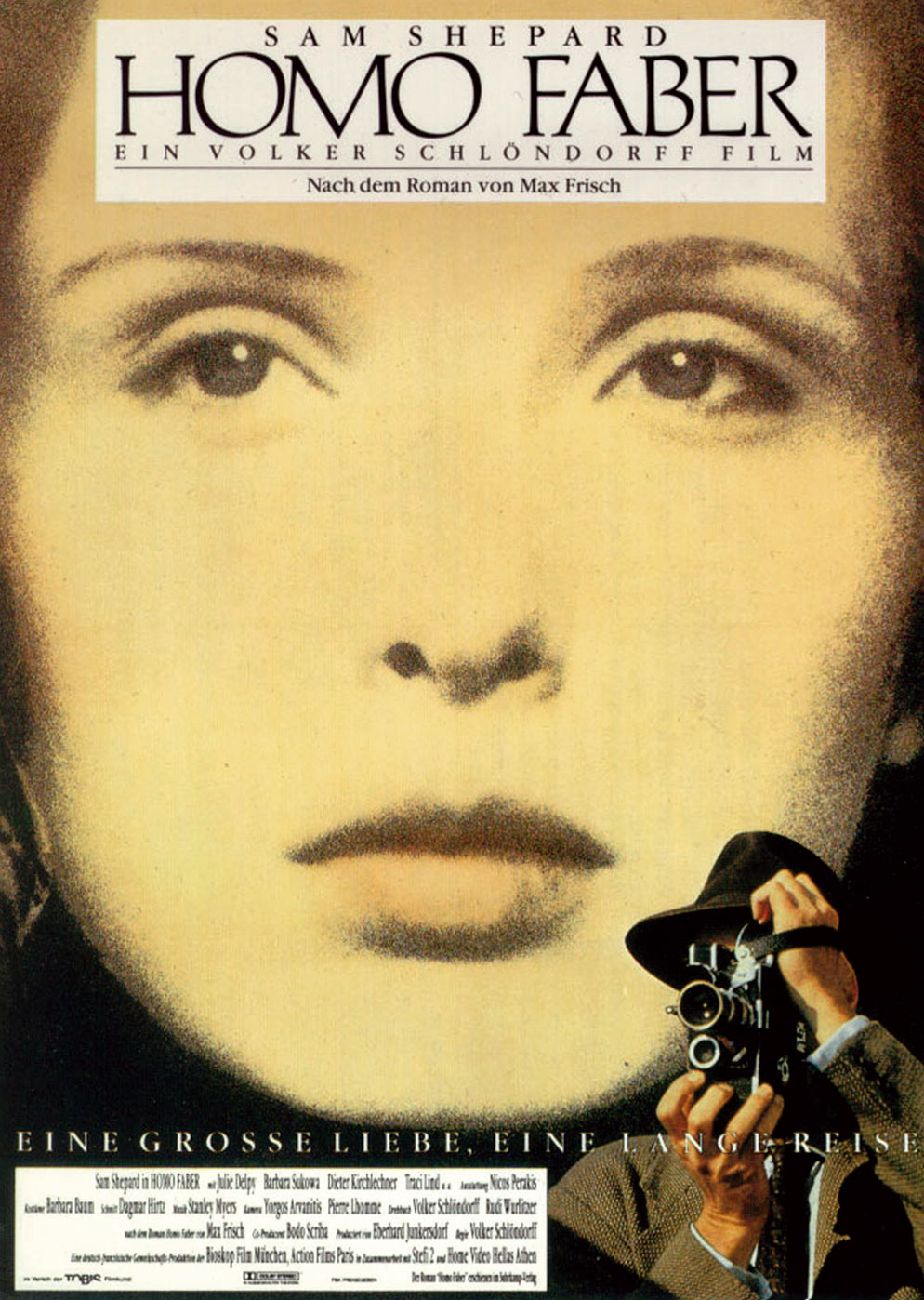
In Germany they teach this novel in school, but in the rest of the world anyone who hadn't read Max Frisch might think it was a gay movie. To avoid such confusion the title was changed to VOYAGER, which isn't at all inaccurate because Walter Faber is always travelling and when he makes things they're not tools but problematic situations.
On this film my work was more production than design, because I had to find locations in all the countries Faber visits, as well as some difficult period items such as an ocean liner in the Mediterranean and a Super Constellation aeroplane that would make a crash landing in the Sonora desert. Here is a rough 200-word outline of the story to help anyone who hasn't read the novel understand how all this material fits in.
Before the second world war civil engineer Walter Faber – American in the film – falls for the Jewish art student Hanna. When she tells him that she is pregnant Faber wants to marry her but she hesitates since she doesn’t want to keep the child. He departs for a dam project in Iraq and leaves Hanna to marry his best friend Joachim.
On a flight to Caracas in the spring of 1957, Faber meets Joachim’s brother Herbert and after the plane crash-lands in the Sonora desert, Faber follows him in search of his brother in Mexico. When they arrive at Joachim’s plantation they find him hanging among his tobacco leaves. Faber returns to New York where his married mistress Ivy is waiting for him and to escape the relationship leaves abruptly for Europe.
On the ship he meets the student Sabeth with her boyfriend and he falls in love with her. They meet again in Paris and he offers to drive her to Greece where she will meet her mother Hanna. His evil foreboding is confirmed after their arrival in Greece when his beloved Sabeth dies after a snakebite and her archaeologist mother Hanna confesses that Sabeth was his own daughter.

ZWEI FRAUEN
SILENCE LIKE GLASS

The film, like Bea Hellman's novel, was based on her personal experience with cancer and tells of the relationship and psychological ups and downs of two young women who share a room in a cancer treatment clinic. In 1989 my only hospital experience had been at the 401 Army Hospital where, for a dislocated knee, they put my whole leg in a plaster cast. It was in 1968, when the junta as colonel Papadopoulos said, “put the whole country in plaster”.
In addition, the story ή is set in an American hospital, part of which, including the operating room, I had to build on a sound stage. Bavaria’s intention was to make a movie that no American doctor would notice was filmed outside the U.S. So I went to New York to get a close look at Mount Sinai and the NY-University Hospital, and the pediatric clinic of the Dana-Farber Cancer Institute in Boston. Not only was the cast all American, the operation was done by a surgical team from the American Military Hospital in Munich. Fortunately I was able to consult them throughout the production for information and advice. At the end they brought their own surgical instruments to operate on the pig belly they had ordered, because as I learned, human tissue closely resembles the piglet’s. I also learned that hospital equipment and medical instruments are supplied by just a few German and American multinationals, which, probably due to BAVARIA, were very co-operative.

DES TEUFELS PARADIES
DEVIL'S PARADISE
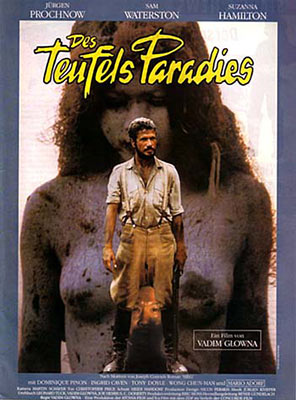
based on the novel "Victory" by Joseph Conrad
Vadim was an actor and had played lead roles in over 100 movies when he decided to take up directing. I had known him through friends like Roland Gall and Joe Hembus. We had both worked with, but also through, George Panousopoulos, since they wanted to shoot a modern western in Arizona. Finaly Vadim made his "Desperado City" alone, while George shot his "Honeymoon".
Vadim placed the "Devil's Paradise" story in the interwar period on a little Indonesian island with an active volcano, and in the Dutch colonial city Surabaya. He had made a quick scouting trip to Penang and Surabaya, but the first of his troubles was that the insurers categorically precluded the location claiming that Suharto didn’t have control of all 3,000 islands.
The same thing happened to us in the Philippines, where we wanted to look for islands with mines and volcanoes, but after the Marcos-Aquino change martial law was declared in Mindanao, which had many volcanoes, and in Cebu. We saw the National Park near Manilla, where Coppola shot his "Apocalypse Now", and we did a little volcanic tourism around Pinatubo and Mayon. On the way to Magaso we luckily saw what was then perhaps the most primitive coal mine in the country. See LOCATIONS.
So we went to Thailand where Georg Mertensmeyer was waiting for us. He was a German resident of Bangkok running a company servicing foreign productions. We nearly had the same problem here, because in the non-tourist south that interested us, trucks drove in convoys at night in fear of the gangs that robbed cars on highways. Georg's production manager was William Melcher, a Vietnam veteran who stayed behind in Bangkok to prepare the rest of the location scouting while we started for the south. Fortunately, Georg understood exactly what we wanted and took the risk.

DER MANN AUF DER MAUER
THE MAN ON THE WALL

The screenplay by Peter Schneider was based on the short story "Der Mauerspringer" (The Wall Jumper). The hero, the young East Berliner Kabe, comes and goes between East and West Berlin passing over and under the wall with ladders and hang gliders or on routes used by agents. Besides the counterintelligence agencies waiting for him, there are his women in both sectors of the city.
The basic set of the film was a long section of the wall with all its ancillaries: checkpoints, floodlights, guardhouses, watchtowers, trenches, minefields, booby-trapped zones wired with automatic firearms, and wolfhounds. At the same time we had to find public places and streets in West Berlin that would do for plausible locations in the East, where there was no way to get a shooting permit. I went to the East many times to get a feeling of the atmosphere and on each visit I bought a few typical products at a supermarket because we had to set up the household of Kabe’s eastern companion. Having read the script carefully I took all precautions and not a single photo.
Once I finished the "research" I combed the west side of the wall to photograph construction details since we knew that it had been erected with prefabricated components, and to locate a large site where we could build ours. The creepy thing was that the best location was a vacant lot 150 meters from the actual wall. When we finally erected the set our workmen's favorite joke was to respond to the confused old ladies who had to pass through our checkpoint set to visit their relatives, that the wall would be extended and they had to be back before sunset.
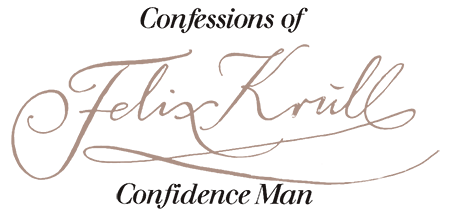
BEKENNTNISSE DES HOCHSTAPLERS FELIX KRULL
CONFESSIONS OF CONFIDENCE MAN FELIX KRULL
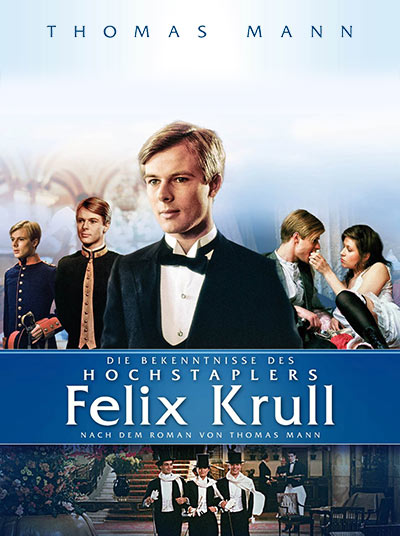
5-episode series by Bernhard Sinkel
Thomas Mann's hero is not a common crook, and a "Hochstapler" is not only what would be called in English a confidence man and in French a chevalier d'industrie, a widespread social phenomenon in our country. As we have seen recently, this does not mean that somebody can’t be both an important person and a crook. BETA Film intended to make an ambitious European TV series and Mann's novel was perfect in every way. Set just before the end of the belle époque, it has European aristocrats and nouveau-riche cosmopolitans, bon viveurs, artists and luxury courtesans in metropolises of wealth, hotels, casinos, vaudeville and brothels. Ideal for a production that was intended for broadcast throughout Europe was the fact that the series required a multinational cast. I don’t know if the commercial result was satisfactory or if it helped that the role of the German Felix was played by the Englishman John Moulder-Brown, but I lived a wonderful experience during scouting and then shooting in the best hotels and restaurants in Europe just before they were renovated. We were even in time for the Museu Nacional de História Natural of Lisbon, which had not changed since 1861. On top of all this I had the chance to meet - and dress - Μagali Noël whom I hadn’t seen since Felini’s films. When as a schoolboy I first saw her her in 1959 in a film titled in Greece "Hot Blazing Flesh" (L'Île du bout du monde), it caused me an adolescent trauma. But there was still a positive development. At a moment when I had to transfer more rights to the production company, BETA bribed me by promising participation in my next film. They didn’t know that this would be Αrpa Colla and they gave me a lot of trouble, but the film was shot.

ΟΙ ΑΠΕΝΑΝΤΙ
I APENANTI (THOSE OPPOSITE)

My contribution to the film was small and more supportive than substantial. It was limited to Charis's austere room, the petty-bourgeois household of Stella, and an old spyglass that had to be retrofitted as a plausible telescope.
George had found most of the locations and we saw them again just for an alternative proposal or idea, but I also had to integrate my multinational art department staff in the unit – see IMDb – the Swede Siv as props woman, the American Tom as construction co-ordinator and Lambros, a Greek fanatical Greek biker who was put in charge of transportation. And I had to go back to primitive illustrated lists as a means of communication. I mustn't forget the German Heidrun, who was in training for her subsequent work as costume designer on Arpa Colla.
The last time I saw APENANTI was at the Open Air Festival 2013 in Abyssinia Square with Betty Livanou beside me, and when the camera entered Stella's apartment and I wondered aloud where we had managed to find all the household furnishings she replied stoically:
You raided my place!

ENGEL AUS EISEN
ANGELS OF IRON

Thomas Brasch was a poet, dramatist and director. He was born in England to exiled Jewish communist parents and grew up in the DDR, i.e., the German Democratic Republic, where the second adjective may be a pleonasm, but somehow it had to stand out from the Western, Federal, revanchist and capitalist one. Nevertheless Thomas, who went for a few years to the National Cadet School of the People's Army before he studied dramaturgy at Babelsberg, never missed an opportunity to criticize the regime, with the result that he was expelled from schools and universities and worked as waiter, blacksmith and field hand.
In 1976 he finally managed to get banished from the Republic and moved to West Berlin with his life companion Katharina Thalbach, yes, the one who played the stepmother and mistress of Oskar in "Tin Drum". And when he decided to shoot a film with my associate von Vietinghoff as producer, they put me into the package. The truth is that I wanted to do it because they had hired cinematographer Walter Lassally whom I knew little and admired a lot, but had never worked with.
The scenario was based on a true story of the Cold War, the blockade of Berlin in 1948 by the Soviet Union and the Allied airlift to supply the city. Twenty-year-old Werner Gladow sets up a violent gang of 80 juveniles and by various tricks circulates counterfit money, first on the Alexanderplatz black market and later in the whole of West Berlin. Gladow has the misfortune to get busted in the Eastern Sector where the death penalty is still in force and there is even an executioner for the guillotine, which of course I had to build. I teased Thomas calling him "Stürmer und Dränger", which would mean "stormy and stressy" if it weren’t incorrect German, but everyone understood.

DIE BLECHTROMMEL
THE TIN DRUM

After my "amicable" withdrawal from THE LOST HONOUR OF KATERINA BLUM, I did not expect to be offered another job by Volker and Eberhard, his partner in BIOSKOP FILM, especially THE TIN DRUM, already a small sensation, based on the shooting announcement alone. My joy was short-lived because it didn’t take long to learn that I was not the first choice and a colleague had just withdrawn before the location scouting, and for reasons that were so obvious that I didn't even bother to ask.
The challenge was too great to refuse, or at least first read the script to know what would be in store for me. The movie would be filmed as a German-French co-production – in co-operation with studios – in Berlin, Gdansk, Zagreb, Paris, Normandy and Munich, but only because in BAVARIA’s back lot there was a set of a bombed street, once built for Bergman’s SERPENT’S EGG. The only positive thing was that I had inherited my predecessor's assistant Bernd, a talented graphic artist who had done awesome research in photo archives and libraries and had never worked on a film, but was determined to become a set designer. Bernd moved into my apartment where there were a drawing board and large tables, also my ex-girlfriend, an architect who helped us with line drawings, and a the current one who was hired as caterer to the art department. Unfortunately most of the time I was travelling because I had to recce all locations with Volker, then sketch the sets and come back with the final drawings for the local colleagues, who had the supervision, and be back for the finishing touches and deliver the set before the crew arrived for the shooting.
I do not remember if we went first to Berlin or Gdansk, but I'm sure that even on the plane I scribbled in the 230-page script my lists of sets in locations and countries. At first I collected boarding cards, but after 20 flights I lost count.

TAUGENICHTS
GOOD-FOR-NOTHING
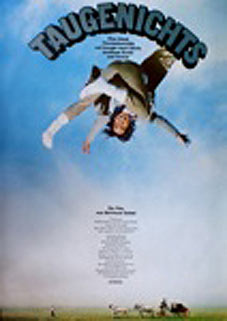
The script written by Alf Brustellin and Bernhard Sinkel is a free adaptation of a novella by the German romantic Joseph von Eichendorff "From the Life of a Good-for-nothing", which I remembered from my German literature book.
Thomas Mann once wrote about "Good-for-nothing": "But the novel is nothing less than well mannered, lacking any serious depth, any psychological ambition, any deliberate social criticism, and any intellectual discipline. It's nothing but dream, music, relaxation, the sounds of the postal horn, wanderlust, nostalgia, homesickness, fireworks in a night park, senseless bliss, so that your ears are buzzing from poetic charm and confusion."
This might also describe the movie if we add a dose of arbitrariness and lots of anarchy. On Bernhard's website there is a lot of material, data and notes, but I also found a related interview (in German). The film was shot in Prague, in and near the Veltrusy mansion, and around Rome, to which, in the 19th century, all romantic roads led. The bulk of my work was of course the costumes, hair and make-up as I had many good partners: Barbara Mathée at the costume department and for the sets Karel Vacek in Prague and Franco Chianese in Rome. Replaying the titles of the film I felt a strange loneliness. Many friends and partners on the film including the co-screenwriter Alf Brustellin, the cinematographer Dietrich Lohman, the composer Hans Werner Henze and the co-producer Bernd Eichinger are gone. The latter just recently. Last year when I visited the new building of the Munich Film School I stopped awhile to admire the impressive architecture on the square that bears his name.
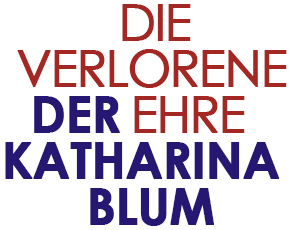
DIE VERLORENE EHRE DER KATHARINA BLUM
THE LOST HONOUR OF KATHARINA BLUM

PRE-PRODUCTION
The years 1974 and '75 were hell: So many movies that I don’t remember the order they were filmed in, which one in the spring and which in the winter. Apart from all this, at U.L.M. there was a continual production of short films for pre-schoolers, to be incorporated in "Sesame Street". These films where shot by whoever of the "partners" had time, to cover the fixed costs of the company. KATHARINA BLUM started the classic way: we were researching the characteristics of the period, the locations in Cologne, the terrorism of the mass media, but seeking the ideal casting for Katharina, the production was constantly being postponed for reasons not even Volker talks about anywhere, so...
Although I had already done a lot of thankless work I decided to resign and retire discreetly to avoid finding myself later in a worse dilemma, since the shooting of "BERLIGER" by my U.L.M. partners Brustellin and Sinkel was already planned.
Volker finally found Angela Winkler so the postponements worked out for the best.
Of course I delivered all the location scouting material and kept only a few drawings with the look of the film: Katharina's depressive environment, the coldness of the antiterrorist squad, the colourful suffocating carnival of Cologne, and the layout of the yellow paper DIE ZEITUNG. As background of the page we put the 25/02/1975 issue of the tabloid BILD, beloved in Greece, with the headline: "Baader-Meinhof (the gang) now eating caviar in their cells". Reminds me a little of some of the reports from the VIP wing of our Korydallos prison.

BERLINGER
THE OUTSIDER

With the subtitle "A German Adventure" Alf and Bernd tried to relieve the movie and the "New German Cinema" from the "collective responsibility" complex that had caused a stagnation with themes like: "The sins of the fathers shall be visited on the sons". The fact that they were both friends and also descendants of diametrically opposite social classes, one from an old family of industrialists and the other the son of an aviator, was a big help to me. The shooting was an adventure for me too, but also an opportunity to immerse myself in the old and new Germanic self-consciousness.
In my folders I found unfortunately only sketches of scenes or the main characters and not a single construction plan.
On Bernd's site there are lobby cards and some scenes, focused naturally on the stars in the cast.
I have added only a few scenes and frames from a poor PAL copy without subtitles.